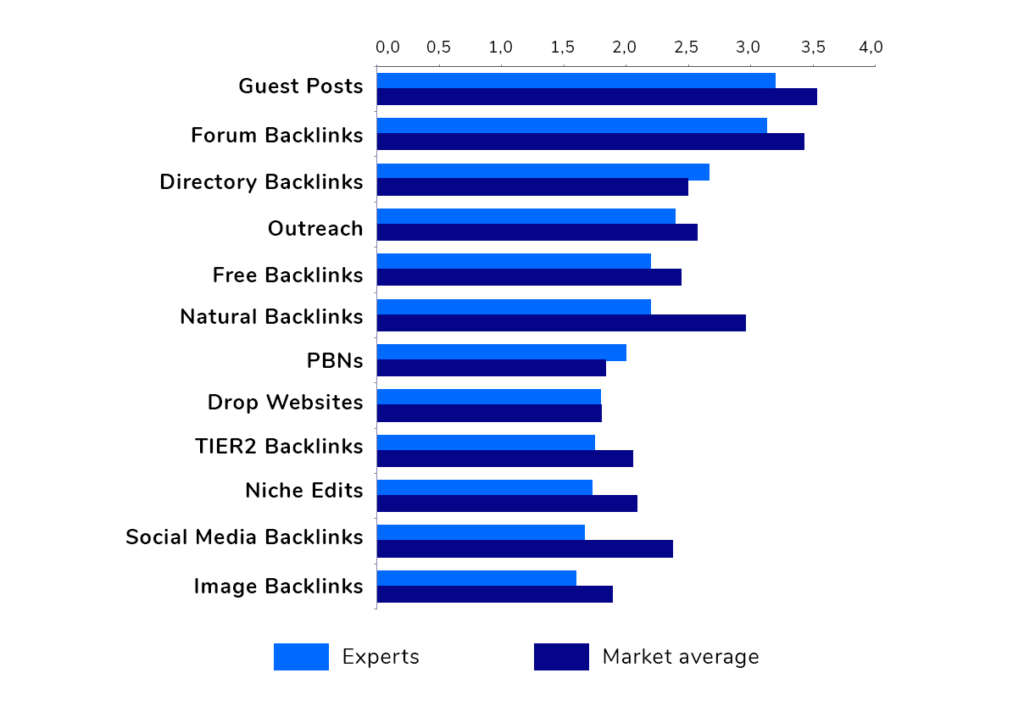Link building is a complex process, and there are many mistakes that can negatively impact the final result. Therefore, it’s better to be aware of potential difficulties and prevent them where possible.
Instead of experimenting randomly and risking, it’s better to use proven expert methodologies. Let’s look at where inexperienced link builders usually stumble.
Mistake 1: Monotonous Links
Looking at any project in the top of Google, its link profile will be diverse and originate from various sources. This is not a coincidence.
A recent study by Serpzilla showed that most link builders use links of different types, regardless of which type forms the basis of the link strategy.

Using Different Types of Links in Link Building Strategies
Some SEO-specialists come to services and purchase only one type of link, believing this to be sufficient. This practice contradicts the logic of natural growth of a link profile. As a site becomes more popular, it gets more diverse references. If all links are monotonous and their number increases, this can raise suspicion in the eyes of Google.
Mistake 2: Sudden Jumps
This mistake is still relevant, especially for young projects. If you want to achieve maximum effect in a short period, remember the potential negative reaction from Google.
In most cases, a sudden increase in links is perceived as manipulation. The result is search engine penalties, making it extremely difficult to recover the project from under the filter. In some cases, this can have severe consequences – Google, for example, may completely remove a penalized site from its index.
There are situations where a sudden increase in links occurs naturally. For instance, a company launches a new relevant product, and news articles are immediately published about it. Search engines usually react calmly to this. Theoretically, a Publisher can use this when promoting a news site, but it’s better to avoid abrupt jumps in the link profile.
Mistake 3: Risky Anchor List
There are various studies and hypotheses about the “correct” ratio of anchor links (containing commercial or informational words) to non-anchor links. For example, Serpstat considers it optimal to place 1 anchor link for every 3 non-anchor links. There are other viewpoints, but they all agree on one thing: you can’t work with anchors alone.
Based on Serpzilla’s client cases, we believe there is no golden rule. Moreover, you can try increasing the share of anchor links compared to competitors – for example, by 5%. It’s quite possible that this way, you can advance in search rankings.
However, there are still projects where anchors make up 100%, and other types of links are absent. Search engines may perceive such a link profile as unnatural.
The combination of words and their variations in anchors also play a role in link effectiveness. Foreign SEO specialists offer their versions of using anchors. For example, in a ReputationX study, SEO-specialists advise not making all anchor links identical but distributing them in roughly equal parts according to the following types:
- Anchors with direct mention of the brand or keywords
- Partially matching anchors
- Pure URL of your site
- Natural anchors, not mentioning brands or keywords
Mistake 4: Dubious Sources
This error is one of the most pressing. Some SEO-specialists simply want to save money and buy links in bulk, so-called “off the shelf.” It’s easy to find special offers from Publishers online, offering large numbers of links wholesale. The desire to cut costs is understandable, but such savings can cause significant harm.
Other SEO-specialists simply don’t know what to focus on when buying links and how to select donor sites. In this case, too, there’s a high risk of getting a link from a spammed resource, trading links in large quantities. The harm from such a link may outweigh its benefits – you spend money, but the link does not contribute to link weight.
Interestingly, sometimes perfectly successful sites are mistakenly taken for unreliable link donors. Traffic dips can be due to seasonality of queries, and metrics analysis can confirm this. However, if traffic is consistently degrading, it’s risky to purchase links on such a site, even if it has high parameters and an attractive price.
Search engines may also consider links with different regional bindings as dubious. Some sites sometimes struggle to get suitable thematic links within their region. In this case, they resort to buying links from resources in other regions, risking penalties.
For example, a site offers products and services with a clear local focus – like an auto parts store in a specific city. However, it is not part of a franchise and does not have branches in other locations, but for promotion, it buys links from sites with different regional bindings. Search engines are likely to consider such an increase in the link profile as manipulation.



